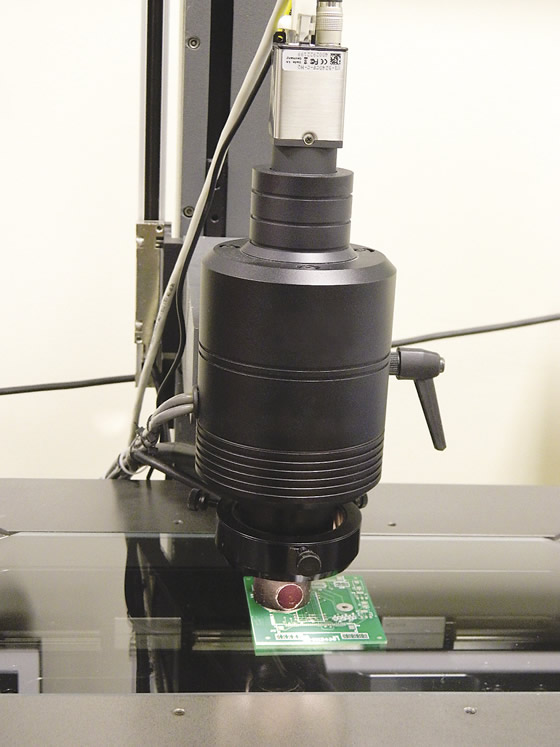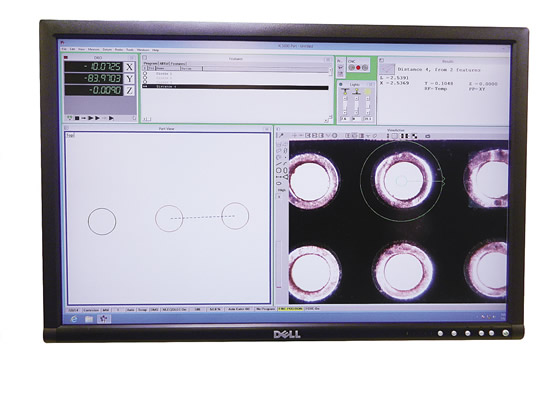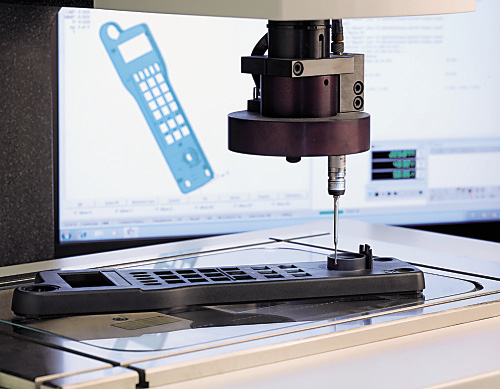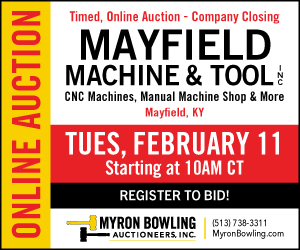Parts manufacturers must meet demanding quality standards. Therefore, part inspection throughout the manufacturing process is required. This critical step is generally done in a QC or engineering department using various inspection methods. One method utilizes video camera-based measurements in conjunction with metrology software and offers unique benefits.
The greatest benefit of a video inspection system is its ability to capture large numbers of data points with a single mouse click, which generates accurate and repeatable results. When many data points are gathered, algorithms can use those points to accurately determine the size, location and form of the part. In addition, the software within the system often can filter out data that may have been taken in error. This noncontact inspection method is especially beneficial when the part is too small or fragile to be measured with standard touch probes.

Courtesy of All images: Heidenhain
Video inspection of a circuit board.

This screen shot shows video inspection using Heidenhain’s IK 5000 QUADRA-CHEK metrology software.
Advancements in digital cameras over the past 5 to 10 years, in combination with proven metrology software and accurate position feedback, can help companies produce higher-quality parts because inspectors can quickly and accurately verify quality throughout the manufacturing process. Applications that could benefit from this type of system include stamped and milled metal products, sprockets, gears, hubs, circuit boards and connectors.
Metrology software tied to a video system guides the inspection process and gives the operator tools to simplify on-screen measurements taken directly from the camera. The video “tools” use pixel resolution to find the edges of parts by detecting slight changes to the contrast levels seen in the image. These tools can be set up to accommodate various part sizes and shapes, and adjusted for the number of locations used for measurement.
The metrology software provides an interactive user interface to make manual measurements and easily create automated programs. When connected to an inspection machine, most video-based inspection software will allow users to adjust lighting intensity and change magnification settings with the press of a button. These adjustments make it possible to achieve a good image of the item being inspected. By using the edge detection tools on the live video image, the software determines where the edge of a part is located, creates a digitized feature and draws it on the screen. Once the image is captured, verifying the blueprint measurements is a simple point-and-click process.
Heidenhain’s IK 5000 QUADRA-CHEK metrology software, for example, has 15 video measurement probes available, each with specialized functionality. This allows users to run programs for applications where they need to quickly and easily measure angles and distances and perform profile comparisons.

A probe is incorporated into Heidenhain’s IK 5000 QUADRA-CHEK metrology system.
When a touch probe is added to the measurement system, the inspection device becomes even more versatile. Combining the features of touch probes for 3D measurement and video tools for fast and accurate XY-plane measurements provides the flexibility to program specific measurement functions.
Using inspection devices with motorized hardware offers additional functionality, such as joystick and trackball control of the stage, programmable zoom levels and automatic focus. The metrology software makes it possible to use these additional functions, creating a video inspection system that is especially helpful when measuring height and surface flatness. Each time another part is measured, the same settings can be selected automatically.
A metrology software-supported video inspection system can be the answer to many part production QC scenarios, particularly complex ones. The system enables users to simply press a button to begin the process. CTE
Related Glossary Terms
- metrology
metrology
Science of measurement; the principles on which precision machining, quality control and inspection are based. See precision machining, measurement.








